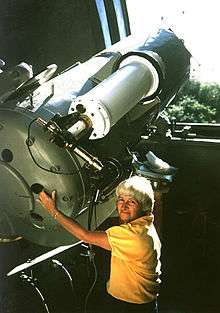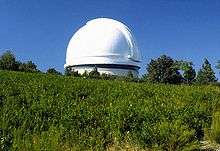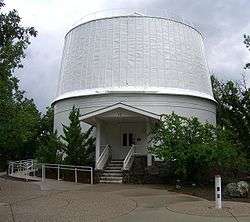Carolyn S. Shoemaker
Carolyn Jean Spellmann Shoemaker (born June 24, 1929)[1] is an American astronomer and is a co-discoverer of Comet Shoemaker–Levy 9.[2] She once held the record for most comets discovered by an individual.[3]
Carolyn S. Shoemaker | |
|---|---|
 | |
| Born | June 24, 1929 |
| Nationality | American |
| Citizenship | American |
| Alma mater | California State University, Chico |
| Known for | co-discoverer of Comet Shoemaker–Levy 9 |
| Spouse(s) | Eugene Shoemaker 1951–1997 (his death) |
| Awards | James Craig Watson Medal (1998) National Aeronautics and Space Administration, Exceptional Scientific Achievement Medal Rittenhouse Medal (1988) Scientist of the Year Award (1995) |
| Scientific career | |
| Fields | Astronomy |
| Institutions | California Institute of Technology Palomar Observatory, California |
Although Shoemaker earned degrees in history, political science and English literature, she had almost no interest in science until after she met and married geologist Eugene M. ("Gene") Shoemaker in 1950–51. She said later that his explanations of his work thrilled her. Despite her relative inexperience and her lack of a relevant scientific degree, Caltech had no objection to her joining Gene's team at the California Institute of Technology as a research assistant. Shoemaker had already shown herself to be unusually patient, and she had already demonstrated exceptional stereoscopic vision, both qualities were extremely valuable in a career looking for objects in near-earth space.[3]
Early and personal life
Carolyn Lash Spellmann was born in Gallup, New Mexico, United States,[3] to Leonard and Hazel Arthur Spellmann. Her family moved to Chico, California, where she and her brother Richard grew up. Spellmann earned bachelor's and master's degrees in history, political science, and English literature from Chico State University.[4] Richard went to the California Institute of Technology (Caltech), where he earned a bachelor's degree in chemical engineering. Richard's roommate at Caltech was a young graduate student named Gene Shoemaker. Carolyn did not meet Gene until the summer of 1950, when she attended her brother's wedding.[3] Gene had moved to New Jersey by 1950, to begin work toward a doctoral degree at Princeton University, but flew back to California to serve as Richard's best man. He then returned to his studies at Princeton. However, Carolyn and Gene maintained a "pen pal" relationship. They followed this with a two-week camping trip on the Tennessee Plateau. On August 18, 1951, Carolyn and Gene married.[3][5] Gene Shoemaker would go on to become a pioneer in the field of astrogeology. The couple had three children: Christy, Linda, and Patrick (Pat) Shoemaker.[3] The family lived in Grand Junction, Colorado; Menlo Park, California; and Pasadena, California; before finally settling down in Flagstaff, Arizona, where she worked in collaboration with her husband at the Lowell Observatory.[5]
Careers

The first job Shoemaker held after marrying Gene was teaching the seventh grade. Feeling unsatisfied with the teaching profession, she quit to raise a family. Mary Chapman, author of Shoemaker's biography for the USGS Astrogeology Center, wrote "Carolyn is a warm, caring, and extremely patient woman, but her skills were better suited for a non-teaching environment.[3]
At the age of 51, after her children had grown up and moved out, Shoemaker started looking for work that would combat her "empty nest syndrome." In her youth, she had never been interested in scientific topics. She had taken one course in geology, but found it extremely boring. Meeting Gene had changed all that. She reportedly told others that,"listening to Gene explaining geology made what she had thought was a boring subject into an exciting and interesting pursuit of knowledge."[3]

A student at Lowell Observatory began teaching her astronomy. Then she began work as a field assistant for her husband, working on his search program mapping and analyzing impact craters.[4] Carolyn Shoemaker started her astronomical career in 1980, at age 51, searching for Earth-crossing asteroids and comets at California Institute of Technology, Pasadena, California, and the Palomar Observatory, San Diego, California.[6] That year, Shoemaker was hired at the United States Geological Survey (USGS) as a visiting scientist in the astronomy branch, and then in 1989 began work as an astronomy research professor at Northern Arizona University.[4] She concentrated her work on searching for comets and planet-crossing asteroids.[5] Teamed with astronomer David H. Levy, the Shoemakers identified Shoemaker-Levy 9, a fragmented comet orbiting the planet Jupiter on March 24, 1993.[7][8]
In the 1980s and 1990s, Shoemaker used film taken at the wide-field telescope at the Palomar Observatory, combined with a stereoscope, to find objects which moved against the background of fixed stars.[3]
In 1997, Gene and Carolyn were involved in a car crash in Australia. Gene was killed instantly, while Carolyn sustained severe injuries. Carolyn eventually recovered and continued to work at the Lowell Observatory with Levy.[9] She was actively involved in astronomical observation work till at least 2002.[3] As of 2002, Shoemaker had been credited with discovering or co-discovering 32 comets and over 800 asteroids.[3][6]
Awards and honors
Shoemaker received an honorary doctorate from the Northern Arizona University, Flagstaff, Arizona, and the U.S. National Aeronautics and Space Administration Exceptional Scientific Achievement Medal in 1996.[3] She and her husband were awarded the James Craig Watson Medal by the U.S. National Academy of Sciences in 1998.[10] Shoemaker also received the Rittenhouse Medal of the Rittenhouse Astronomical Society[7] in 1988 and the Scientist of the Year Award in 1995. The Hildian asteroid 4446 Carolyn, discovered by colleague Edward Bowell at Lowell Observatory in 1985, was named in her honor.[11]
List of discovered minor planets
Shoemaker is credited by the Minor Planet Center with the discovery of 377 numbered minor planets made between 1980 and 1994.[12]
| List of minor planets discovered by Carolyn Shoemaker | |||||||||||||||||||||||||||||||||||||||||||||||||||||||||||||||||||||||||||||||||||||||||||||||||||||||||||||||||||||||||||||||||||||||||||||||||||||||||||||||||||||||||||||||||||||||||||||||||||||||||||||||||||||||||||||||||||||||||||||||||||||||||||||||||||||||||||||||||||||||||||||||||||||||||||||||||||||||||||||||||||||||||||||||||||||||||||||||||||||||||||||||||||||||||||||||||||||||||||||||||||||||||||||||||||||||||||||||||||||||||||||||||||||||||||||||||||||||||||||||||||||||||||||||||||||||||||||||||||||||||||||||||||||||||||||||||||||||||||||||||||||||||||||||||||||||||||||||||||||||||||||||||||||||||||||||||||||||||||||||||||||||||||||||||||||||||||||||||||||||||||||||||||||||||||||||||||||||||||||||||||||||||||||||||||||||||||||||||||||||||||||||||||||||||||||||||||||||||||||||||||||||||||||||||||||||||||||||||||||||||||||||||||||||||||||||||||||||||||||||||||||||||||||||||||||||||||||||||||||||||||||||||||||||||||||||||||||||||||||||||||||||||||||||||||||||||||||||||||||||
|---|---|---|---|---|---|---|---|---|---|---|---|---|---|---|---|---|---|---|---|---|---|---|---|---|---|---|---|---|---|---|---|---|---|---|---|---|---|---|---|---|---|---|---|---|---|---|---|---|---|---|---|---|---|---|---|---|---|---|---|---|---|---|---|---|---|---|---|---|---|---|---|---|---|---|---|---|---|---|---|---|---|---|---|---|---|---|---|---|---|---|---|---|---|---|---|---|---|---|---|---|---|---|---|---|---|---|---|---|---|---|---|---|---|---|---|---|---|---|---|---|---|---|---|---|---|---|---|---|---|---|---|---|---|---|---|---|---|---|---|---|---|---|---|---|---|---|---|---|---|---|---|---|---|---|---|---|---|---|---|---|---|---|---|---|---|---|---|---|---|---|---|---|---|---|---|---|---|---|---|---|---|---|---|---|---|---|---|---|---|---|---|---|---|---|---|---|---|---|---|---|---|---|---|---|---|---|---|---|---|---|---|---|---|---|---|---|---|---|---|---|---|---|---|---|---|---|---|---|---|---|---|---|---|---|---|---|---|---|---|---|---|---|---|---|---|---|---|---|---|---|---|---|---|---|---|---|---|---|---|---|---|---|---|---|---|---|---|---|---|---|---|---|---|---|---|---|---|---|---|---|---|---|---|---|---|---|---|---|---|---|---|---|---|---|---|---|---|---|---|---|---|---|---|---|---|---|---|---|---|---|---|---|---|---|---|---|---|---|---|---|---|---|---|---|---|---|---|---|---|---|---|---|---|---|---|---|---|---|---|---|---|---|---|---|---|---|---|---|---|---|---|---|---|---|---|---|---|---|---|---|---|---|---|---|---|---|---|---|---|---|---|---|---|---|---|---|---|---|---|---|---|---|---|---|---|---|---|---|---|---|---|---|---|---|---|---|---|---|---|---|---|---|---|---|---|---|---|---|---|---|---|---|---|---|---|---|---|---|---|---|---|---|---|---|---|---|---|---|---|---|---|---|---|---|---|---|---|---|---|---|---|---|---|---|---|---|---|---|---|---|---|---|---|---|---|---|---|---|---|---|---|---|---|---|---|---|---|---|---|---|---|---|---|---|---|---|---|---|---|---|---|---|---|---|---|---|---|---|---|---|---|---|---|---|---|---|---|---|---|---|---|---|---|---|---|---|---|---|---|---|---|---|---|---|---|---|---|---|---|---|---|---|---|---|---|---|---|---|---|---|---|---|---|---|---|---|---|---|---|---|---|---|---|---|---|---|---|---|---|---|---|---|---|---|---|---|---|---|---|---|---|---|---|---|---|---|---|---|---|---|---|---|---|---|---|---|---|---|---|---|---|---|---|---|---|---|---|---|---|---|---|---|---|---|---|---|---|---|---|---|---|---|---|---|---|---|---|---|---|---|---|---|---|---|---|---|---|---|---|---|---|---|---|---|---|---|---|---|---|---|---|---|---|---|---|---|---|---|---|---|---|---|---|---|---|---|---|---|---|---|---|---|---|---|---|---|---|---|---|---|---|---|---|---|---|---|---|---|---|---|---|---|---|---|---|---|---|---|---|---|---|---|---|---|---|---|---|---|---|---|---|---|---|---|---|---|---|---|---|---|---|---|---|---|---|---|---|---|---|---|---|---|---|---|---|---|---|---|---|---|---|---|---|---|---|---|---|---|---|---|---|---|---|---|---|---|---|---|---|---|---|---|---|---|---|---|---|---|---|---|---|---|---|---|---|---|---|---|---|---|---|---|---|---|---|---|---|---|---|---|---|---|---|---|---|---|---|---|---|---|---|---|---|---|---|---|---|---|---|---|---|---|---|---|---|---|---|---|---|---|---|---|---|---|---|---|---|---|---|---|---|---|---|---|---|---|---|---|---|---|---|---|---|---|---|---|---|---|---|---|---|---|---|---|---|---|---|---|---|---|---|---|---|---|---|---|---|---|---|---|---|---|---|---|---|---|---|---|---|---|---|---|---|---|---|---|---|---|---|---|---|---|---|---|---|---|---|---|---|---|---|---|---|---|---|---|---|---|---|---|---|---|---|---|---|---|---|---|---|---|---|---|---|---|---|---|---|---|---|---|---|---|---|---|---|---|---|---|---|---|---|---|---|---|---|---|---|---|---|---|---|---|---|---|---|---|---|---|---|---|---|---|---|---|---|---|---|---|---|---|---|---|---|---|---|---|---|---|---|---|---|---|---|---|---|---|---|---|---|---|---|---|---|---|---|---|---|---|---|---|---|---|---|---|---|---|---|---|---|---|---|---|---|---|---|---|---|---|---|
| |||||||||||||||||||||||||||||||||||||||||||||||||||||||||||||||||||||||||||||||||||||||||||||||||||||||||||||||||||||||||||||||||||||||||||||||||||||||||||||||||||||||||||||||||||||||||||||||||||||||||||||||||||||||||||||||||||||||||||||||||||||||||||||||||||||||||||||||||||||||||||||||||||||||||||||||||||||||||||||||||||||||||||||||||||||||||||||||||||||||||||||||||||||||||||||||||||||||||||||||||||||||||||||||||||||||||||||||||||||||||||||||||||||||||||||||||||||||||||||||||||||||||||||||||||||||||||||||||||||||||||||||||||||||||||||||||||||||||||||||||||||||||||||||||||||||||||||||||||||||||||||||||||||||||||||||||||||||||||||||||||||||||||||||||||||||||||||||||||||||||||||||||||||||||||||||||||||||||||||||||||||||||||||||||||||||||||||||||||||||||||||||||||||||||||||||||||||||||||||||||||||||||||||||||||||||||||||||||||||||||||||||||||||||||||||||||||||||||||||||||||||||||||||||||||||||||||||||||||||||||||||||||||||||||||||||||||||||||||||||||||||||||||||||||||||||||||||||||||||||
References
- Stange, Mary Zeiss; Oyster, Carol K.; Sloan, Jane E. (February 23, 2011). Encyclopedia of Women in Today's World. SAGE Publications. p. 1344. ISBN 9781412976855. Retrieved June 22, 2018.
- Mestel, Rosie (July 9, 1994). "Carolyn Shoemaker and 'Her Comet'". New Scientist. 143 (1933). p. 23.
- Chapman, Mary G. (May 17, 2002). "Carolyn Shoemaker". Astrogeology Science Center. USGS.
- Wayne, Tiffany K. (2011). "Carolyn Shoemaker". Encyclopedia of Women in Today's World, Vol. 4. Thousand Oaks, Calif.: Sage Publications.
- "Shoemaker, Eugene Merle" (2002)
- "She's Looking Out for Us". Explorer. American Association of Petroleum Geologists. May 2001.
- Lang, Susan S. (April 11, 2002). "Comet hunter Carolyn Shoemaker to speak at Cornell April 21". Cornell Chronicle.
- Levy, David H. (July 16, 2014). "Comet Shoemaker-Levy 9: 20 years later". Sky & Telescope. Retrieved August 31, 2019.
- Shoemaker, Carolyn (November 27, 1998). "Space—Where Now, and Why?". Science. 282 (5394): 1637–1638. Bibcode:1998Sci...282.1637S. doi:10.1126/science.282.5394.1637.
- "James Craig Watson Medal". National Academy of Sciences. Archived from the original on June 29, 2010. Retrieved May 18, 2011.
- "4446 Carolyn (1985 TT)". Minor Planet Center. Retrieved March 14, 2018.
- "Minor Planet Discoverers (by number)". Minor Planet Center. September 4, 2016. Retrieved September 28, 2016.